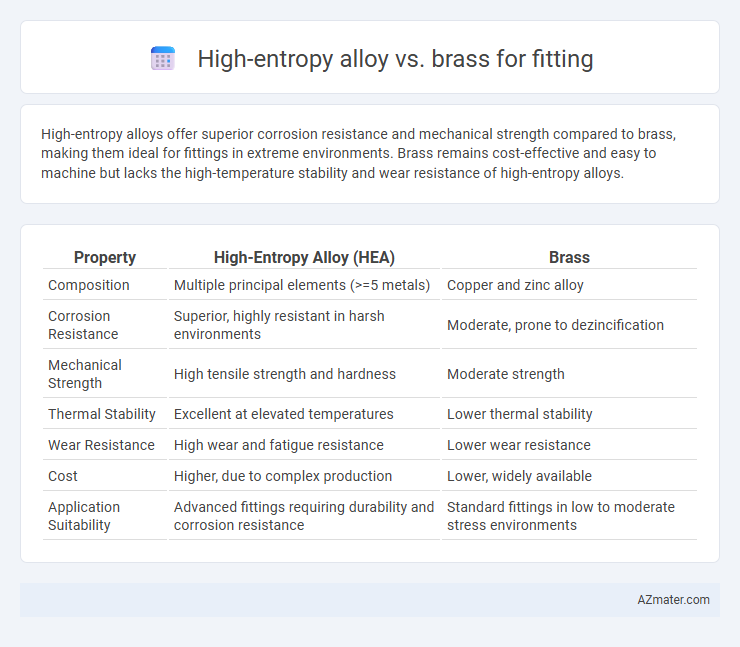High-entropy alloys offer superior corrosion resistance and mechanical strength compared to brass, making them ideal for fittings in extreme environments. Brass remains cost-effective and easy to machine but lacks the high-temperature stability and wear resistance of high-entropy alloys.
Table of Comparison
| Property | High-Entropy Alloy (HEA) | Brass |
|---|---|---|
| Composition | Multiple principal elements (>=5 metals) | Copper and zinc alloy |
| Corrosion Resistance | Superior, highly resistant in harsh environments | Moderate, prone to dezincification |
| Mechanical Strength | High tensile strength and hardness | Moderate strength |
| Thermal Stability | Excellent at elevated temperatures | Lower thermal stability |
| Wear Resistance | High wear and fatigue resistance | Lower wear resistance |
| Cost | Higher, due to complex production | Lower, widely available |
| Application Suitability | Advanced fittings requiring durability and corrosion resistance | Standard fittings in low to moderate stress environments |
Introduction to High-Entropy Alloys and Brass
High-entropy alloys (HEAs) are advanced materials composed of five or more principal elements in near-equiatomic proportions, offering exceptional mechanical properties and corrosion resistance compared to traditional alloys. Brass, an alloy primarily of copper and zinc, has long been favored for fittings due to its excellent machinability, thermal conductivity, and moderate corrosion resistance. While brass remains a cost-effective and widely used material for fittings, HEAs present a promising alternative with superior strength and durability for high-performance applications.
Composition and Material Structure
High-entropy alloys (HEAs) consist of multiple principal elements, typically five or more in near-equal atomic percentages, resulting in a complex, single-phase solid solution with high configurational entropy. Brass, an alloy primarily of copper and zinc, features a more straightforward binary composition with a face-centered cubic (FCC) or body-centered cubic (BCC) crystal structure depending on the zinc content. The multi-element composition and unique lattice distortion in HEAs provide enhanced mechanical strength and corrosion resistance compared to the simpler dual-element, relatively softer microstructure of brass fittings.
Mechanical Properties Comparison
High-entropy alloys (HEAs) exhibit superior mechanical properties compared to brass, including higher tensile strength, enhanced hardness, and improved wear resistance, making them ideal for demanding fitting applications. The multi-element composition of HEAs contributes to excellent corrosion resistance and thermal stability, outperforming traditional brass fittings under high-stress and temperature conditions. Brass, while offering good machinability and moderate strength, generally falls short in durability and fatigue resistance compared to the advanced mechanical performance of HEAs.
Corrosion Resistance and Longevity
High-entropy alloys exhibit superior corrosion resistance compared to brass due to their multi-element composition, which enhances passivation layers and reduces galvanic corrosion. This improved resistance significantly extends the longevity of fittings in harsh environments, including marine and chemical applications. Brass fittings, while cost-effective, are more prone to dezincification and corrosion over time, leading to shorter service life and increased maintenance.
Thermal Stability and Conductivity
High-entropy alloys exhibit superior thermal stability compared to brass, maintaining their mechanical properties at elevated temperatures above 800degC, whereas brass tends to soften and degrade around 200-300degC. The thermal conductivity of brass is relatively high, approximately 100-125 W/m*K, enabling efficient heat dissipation in fittings, while high-entropy alloys have lower thermal conductivity, typically below 20 W/m*K, which can limit their heat transfer efficiency. For applications requiring high thermal resistance and mechanical strength under thermal cycling, high-entropy alloys provide enhanced performance over brass, despite brass offering better conductivity for heat exchange.
Cost and Manufacturing Considerations
High-entropy alloys (HEAs) typically exhibit higher material costs compared to brass due to their complex multi-element composition and advanced processing requirements, making HEAs less cost-effective for large-scale fitting production. Manufacturing HEAs involves precise control of melting and casting processes to ensure homogeneity and desired mechanical properties, whereas brass benefits from well-established, cost-efficient fabrication techniques like casting, machining, and forging. Despite the higher initial cost, HEAs offer potential advantages in wear resistance and corrosion resistance, which may justify their use in specialized fitting applications where durability is critical.
Applications in Fitting Industries
High-entropy alloys (HEAs) offer superior corrosion resistance, mechanical strength, and thermal stability compared to traditional brass, making them ideal for high-performance fitting applications in chemical, aerospace, and marine industries. Brass, known for its excellent machinability and cost-effectiveness, remains popular in residential plumbing and low-pressure fluid systems, but lacks the durability required in extreme environments. The adoption of HEAs in fittings enhances longevity and reliability, particularly where exposure to aggressive chemicals, high temperatures, or mechanical stresses is prevalent.
Environmental Impact and Sustainability
High-entropy alloys (HEAs) exhibit superior corrosion resistance and longer lifespan compared to brass, significantly reducing the frequency of replacements and consequently lowering environmental waste. Brass production involves higher energy consumption and releases more toxic byproducts, whereas HEAs can be engineered with environmentally friendly elements and optimized manufacturing processes enhancing sustainability. The recyclability of HEAs also tends to be more efficient, promoting resource conservation and minimizing ecological footprint in fitting applications.
Performance in Extreme Conditions
High-entropy alloys (HEAs) exhibit superior performance in extreme conditions compared to brass, offering enhanced thermal stability, corrosion resistance, and mechanical strength under high temperature and pressure environments. Brass fittings tend to degrade faster due to lower resistance to oxidation and wear, limiting their use in harsh chemical and high-stress applications. The multi-element composition of HEAs provides exceptional durability and longevity, making them ideal for critical fittings in aerospace, chemical processing, and marine industries.
Future Trends and Innovations in Fitting Materials
High-entropy alloys (HEAs) are emerging as revolutionary materials for fittings due to their exceptional mechanical strength, corrosion resistance, and thermal stability compared to traditional brass alloys. Innovations in HEAs focus on tailoring multi-principal element compositions to enhance durability in extreme environments and reduce maintenance costs in piping systems. Future trends suggest expanding HEA applications in high-pressure and high-temperature fittings, driven by advancements in additive manufacturing and nanostructuring techniques to optimize performance and sustainability.

Infographic: High-entropy alloy vs Brass for Fitting
 azmater.com
azmater.com